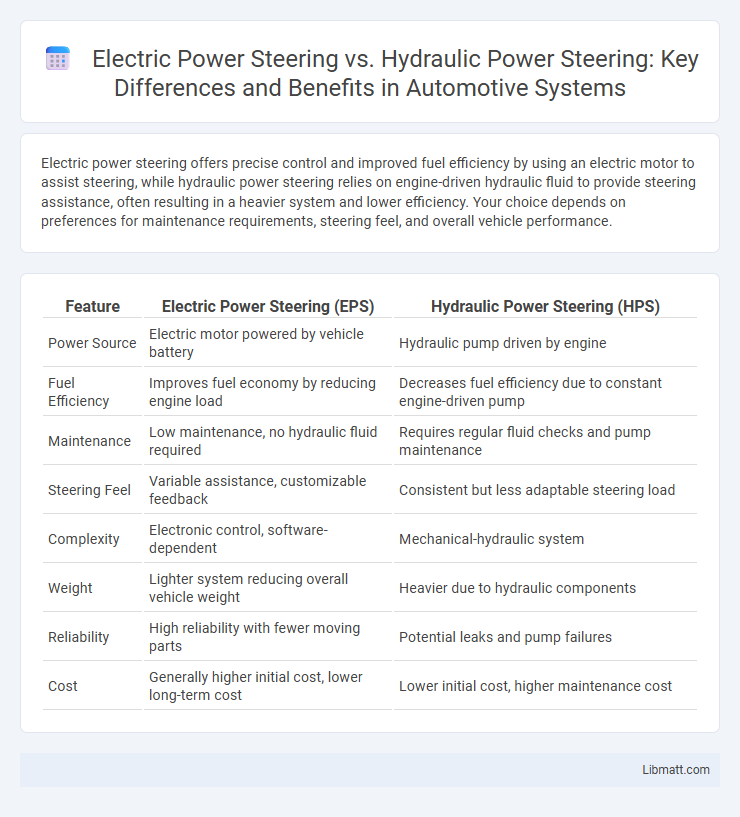Electric power steering offers precise control and improved fuel efficiency by using an electric motor to assist steering, while hydraulic power steering relies on engine-driven hydraulic fluid to provide steering assistance, often resulting in a heavier system and lower efficiency. Your choice depends on preferences for maintenance requirements, steering feel, and overall vehicle performance.
Table of Comparison
| Feature | Electric Power Steering (EPS) | Hydraulic Power Steering (HPS) |
|---|---|---|
| Power Source | Electric motor powered by vehicle battery | Hydraulic pump driven by engine |
| Fuel Efficiency | Improves fuel economy by reducing engine load | Decreases fuel efficiency due to constant engine-driven pump |
| Maintenance | Low maintenance, no hydraulic fluid required | Requires regular fluid checks and pump maintenance |
| Steering Feel | Variable assistance, customizable feedback | Consistent but less adaptable steering load |
| Complexity | Electronic control, software-dependent | Mechanical-hydraulic system |
| Weight | Lighter system reducing overall vehicle weight | Heavier due to hydraulic components |
| Reliability | High reliability with fewer moving parts | Potential leaks and pump failures |
| Cost | Generally higher initial cost, lower long-term cost | Lower initial cost, higher maintenance cost |
Introduction to Power Steering Systems
Power steering systems enhance vehicle control by reducing the effort needed to turn the steering wheel. Electric Power Steering (EPS) uses an electric motor to assist steering, offering precise control and improved fuel efficiency. Hydraulic Power Steering (HPS) relies on a hydraulic pump driven by the engine, delivering consistent assist but often at the cost of higher energy consumption.
How Electric Power Steering Works
Electric Power Steering (EPS) uses an electric motor to assist the driver in turning the steering wheel, enhancing vehicle maneuverability with minimal effort. Sensors detect the steering input and road conditions, sending signals to the motor, which provides the precise amount of assistance needed. Your driving experience benefits from EPS's energy efficiency and adaptability compared to traditional hydraulic power steering systems.
How Hydraulic Power Steering Works
Hydraulic Power Steering operates by using a pump driven by the engine that circulates pressurized hydraulic fluid to assist in turning the wheels. A hydraulic cylinder attached to the steering gear uses this pressure to reduce the effort required from the driver, enabling smoother and easier steering control. Understanding how Hydraulic Power Steering works helps you appreciate its mechanical complexity compared to the more modern Electric Power Steering systems.
Key Differences Between Electric and Hydraulic Power Steering
Electric Power Steering (EPS) uses an electric motor to assist steering, offering improved fuel efficiency and reduced maintenance compared to Hydraulic Power Steering (HPS), which relies on a pump driven by the engine and hydraulic fluid. EPS provides variable assistance based on vehicle speed, enhancing precision and responsiveness, while HPS delivers a consistent level of assistance but is often heavier and less efficient. Your choice between EPS and HPS affects steering feel, energy consumption, and long-term reliability, with EPS increasingly favored in modern vehicles for its advanced control and eco-friendly benefits.
Performance Comparison: EPS vs HPS
Electric Power Steering (EPS) offers precise steering control with variable assistance tailored to vehicle speed, improving fuel efficiency by eliminating hydraulic fluid pumps found in Hydraulic Power Steering (HPS). HPS delivers consistent steering feel and strong feedback through a hydraulic pump driven by the engine, but it causes higher energy consumption and maintenance requirements. Overall, EPS excels in responsiveness and energy savings, while HPS provides robust tactile feedback favored in performance driving.
Efficiency and Fuel Economy
Electric Power Steering (EPS) offers superior efficiency compared to Hydraulic Power Steering (HPS) by operating only when steering input is required, reducing energy consumption and enhancing fuel economy. HPS relies on a constantly running hydraulic pump driven by the engine, which increases parasitic drag and fuel usage even when steering assistance is not needed. Choosing EPS for your vehicle optimizes power usage, leading to noticeable improvements in fuel efficiency and overall driving economy.
Maintenance and Reliability
Electric Power Steering (EPS) systems offer lower maintenance requirements compared to Hydraulic Power Steering (HPS) because they lack hydraulic fluid, pumps, and belts that are prone to leaks and wear. EPS components such as electric motors and sensors generally provide higher reliability and longer service intervals, reducing the frequency of repairs and fluid replacements. Hydraulic systems demand regular checks for fluid levels and potential leaks, making them more maintenance-intensive and susceptible to performance degradation over time.
Cost Considerations
Electric Power Steering (EPS) generally incurs lower maintenance and fuel costs compared to Hydraulic Power Steering (HPS) due to its lighter weight and absence of hydraulic fluid. Your vehicle's initial purchase price might be higher with EPS systems, but long-term savings arise from improved fuel efficiency and reduced component wear. Choosing EPS can enhance overall cost-effectiveness through decreased repair expenses and better energy management.
Applications in Modern Vehicles
Electric Power Steering (EPS) is predominantly used in modern vehicles ranging from compact cars to electric vehicles due to its energy efficiency and integration with advanced driver assistance systems. Hydraulic Power Steering (HPS) remains common in larger trucks and off-road vehicles, offering robust performance under heavy load conditions and rugged terrains. EPS systems contribute to improved fuel economy and precise steering feedback, while HPS provides consistent steering effort in demanding driving scenarios.
Future Trends in Power Steering Technology
Electric Power Steering (EPS) is rapidly advancing with integration of AI and sensor technology to enhance driver assistance systems and energy efficiency. Hydraulic Power Steering (HPS) is gradually being phased out due to higher energy consumption and maintenance demands compared to EPS. Future trends emphasize EPS dominance, driven by widespread adoption in electric vehicles and autonomous driving platforms.
Electric Power Steering vs Hydraulic Power Steering Infographic

 libmatt.com
libmatt.com